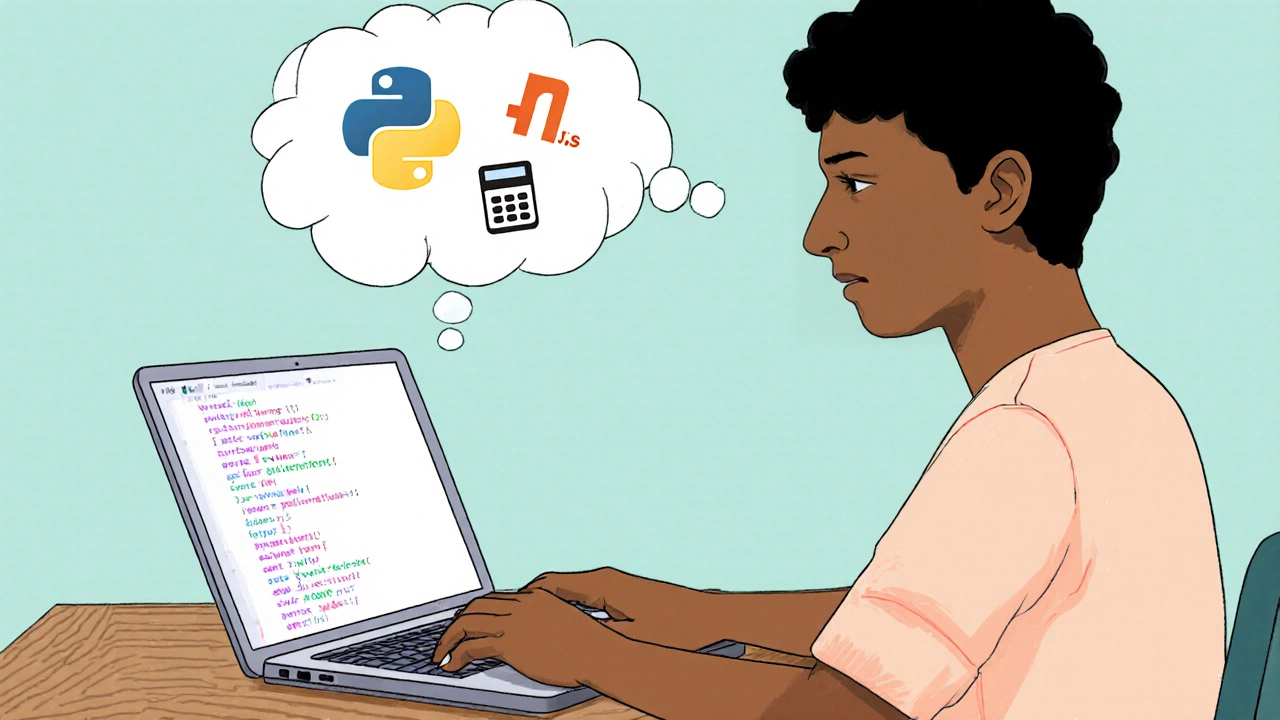Coding Math Requirements Calculator
Which Coding Role Are You Targeting?
When you hear the word Coding is the act of writing computer instructions in a programming language, the first question that often pops up is whether you need a lot of math. The short answer: you need coding math for some tasks, but most everyday programming relies on everyday logic, patterns, and a pinch of arithmetic.
On the other side, Mathematics is the study of numbers, shapes, patterns, and logical relationships. It’s a broad field that ranges from basic arithmetic to abstract algebra. In the programming world, you’ll only touch the parts that help you solve concrete problems.
Everyday math that shows up in code
Most beginner-level projects use just a few math ideas. Here’s a quick rundown of the most common ones and how they appear in real code.
- Basic arithmetic - Adding, subtracting, multiplying, and dividing numbers is the backbone of any calculation, from a shopping‑cart total to a game score.
- Percentages and ratios - Converting a discount, calculating tax, or scaling images all involve simple percentage math.
- Geometry - Positioning elements on a canvas, detecting collision in a 2‑D game, or rotating an object uses coordinates and distance formulas.
- Statistics - Computing averages, medians, or standard deviations is common in data‑analysis scripts and dashboards.
- Boolean algebra - Every Logical reasoning check (if‑else, loops) is built on true/false math.
Why logical reasoning trumps heavy math
Most programming problems are about breaking a task into smaller, repeatable steps. That’s where Algorithms and Data structures come in. You need to know how to sort a list, traverse a tree, or manage a queue - none of which require calculus or linear algebra.
Think of solving a puzzle: you don’t need to know the mathematics behind each piece, you just need a clear strategy. In code, that strategy is often expressed with loops, conditionals, and function calls.
Real‑world coding jobs and their math expectations
| Job Title | Core Math Topics | Depth Needed |
|---|---|---|
| Front‑end Web Developer | Basic arithmetic, percentages, geometry | Low |
| Back‑end Engineer | Algorithms, statistics, discrete math | Medium |
| Data Analyst / BI Developer | Statistics, linear algebra basics | Medium‑High |
| Machine‑Learning Engineer | Calculus, linear algebra, probability | High |
| Game Developer | Geometry, vectors, trigonometry | Medium |
Notice that only niche roles (machine‑learning, advanced graphics) demand heavy math. Most everyday programming jobs sit comfortably in the low‑to‑medium range.

How to start coding if math feels scary
- Pick a beginner‑friendly language. Python and JavaScript have clear syntax and built‑in functions for common math.
- Focus on problem‑solving patterns. Learn loops, conditionals, and functions before worrying about formulas.
- Use libraries for heavy lifting. NumPy (Python) or Math.js (JavaScript) handle matrix math, so you can call
np.linalg.inv()without writing the algorithm yourself. - Practice with real projects. Build a budget tracker, a simple game, or a weather app - each forces you to use just enough math to get the job done.
- Iterate and reflect. After you finish a project, ask: "Which math part felt clunky?" Then look up that specific concept.
Common misconceptions and how to avoid them
- Myth: You need calculus to code.
Reality: Only fields like scientific simulation or deep learning rely on calculus; most apps don’t. - Myth: If you fail a math test, you’ll never be a good programmer.
Reality: Programming is a skill you can improve with practice, just like any other language. - Myth: All algorithms are math‑heavy.
Reality: Many classic algorithms (bubble sort, binary search) are about ordering and decision‑making, not algebra.

Resources to bridge the math‑coding gap
Here are a few free or low‑cost tools that pair math explanations with code examples.
- Khan Academy - Algebra & Geometry: Interactive videos followed by practice exercises.
- freeCodeCamp - JavaScript Algorithms: Each challenge includes a math‑focused walkthrough.
- Project Euler: Problem‑solving site that mixes programming with light math puzzles.
- Codecademy - Python for Data Science: Shows how built‑in libraries abstract the math.
Start with the resource that matches your current comfort level, and gradually move to more math‑intensive material as you feel ready.
Frequently Asked Questions
Do I need to know calculus to become a software engineer?
Only if you aim for specialties like machine learning, computer graphics, or scientific computing. Most web‑development and backend roles rely on basic arithmetic, logic, and simple statistics.
What math concepts are essential for learning Python?
Start with integer arithmetic, string manipulation (counts, slicing), and boolean logic. Later you can explore lists (index math) and libraries like math for trigonometry if needed.
Can I succeed in coding bootcamps without a strong math background?
Yes. Bootcamps focus on practical projects, problem‑solving techniques, and tools that hide complex math. They often provide supplemental modules to cover any needed math basics.
How does discrete mathematics fit into programming?
Discrete math covers topics like sets, graphs, and combinatorics, which directly relate to data structures, algorithms, and network routing. It’s more about logical relationships than continuous equations.
Is learning statistics necessary for a front‑end developer?
Only at a basic level - you might calculate average load times or conversion rates. Deep statistical modeling is typically a back‑end or data‑science concern.



